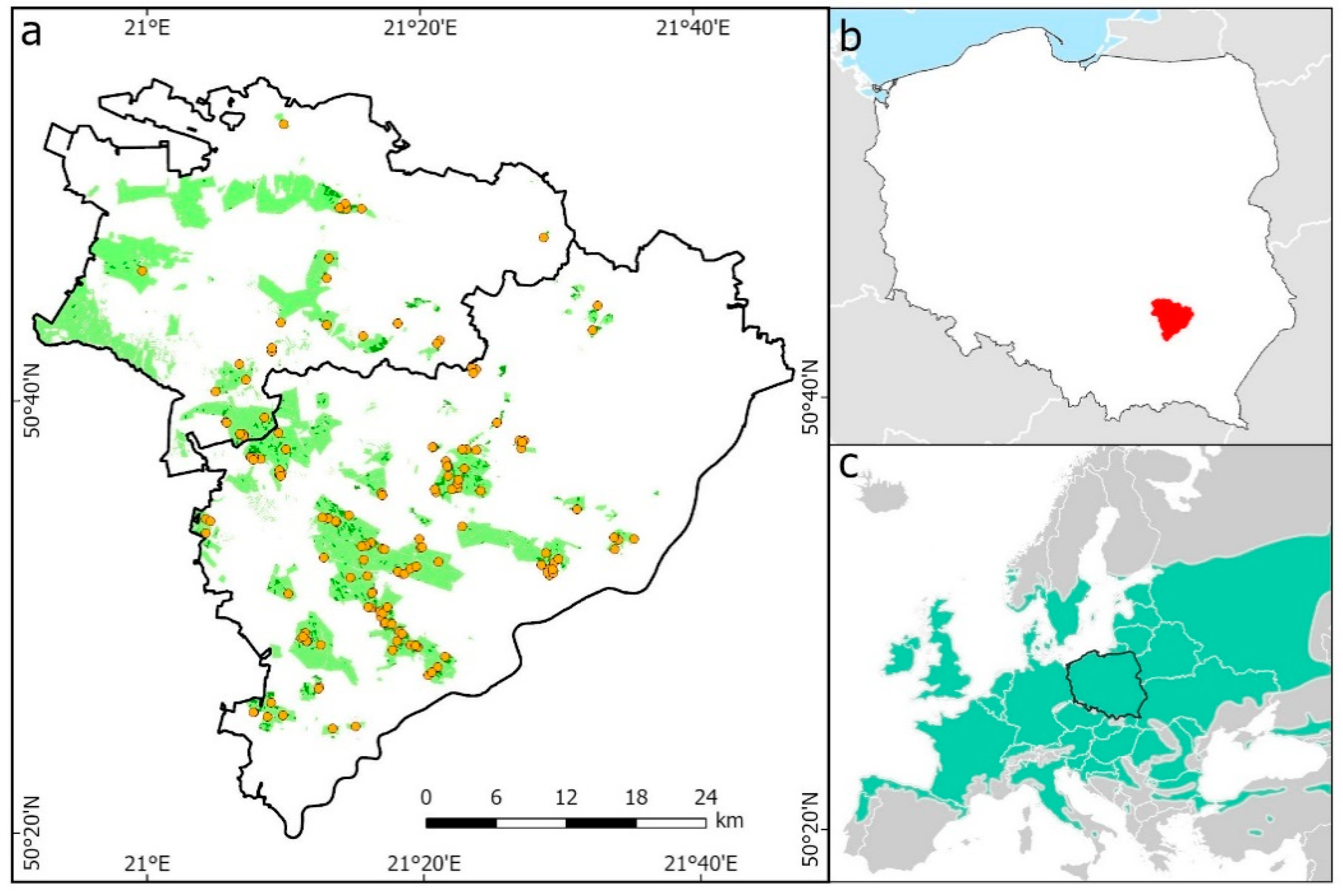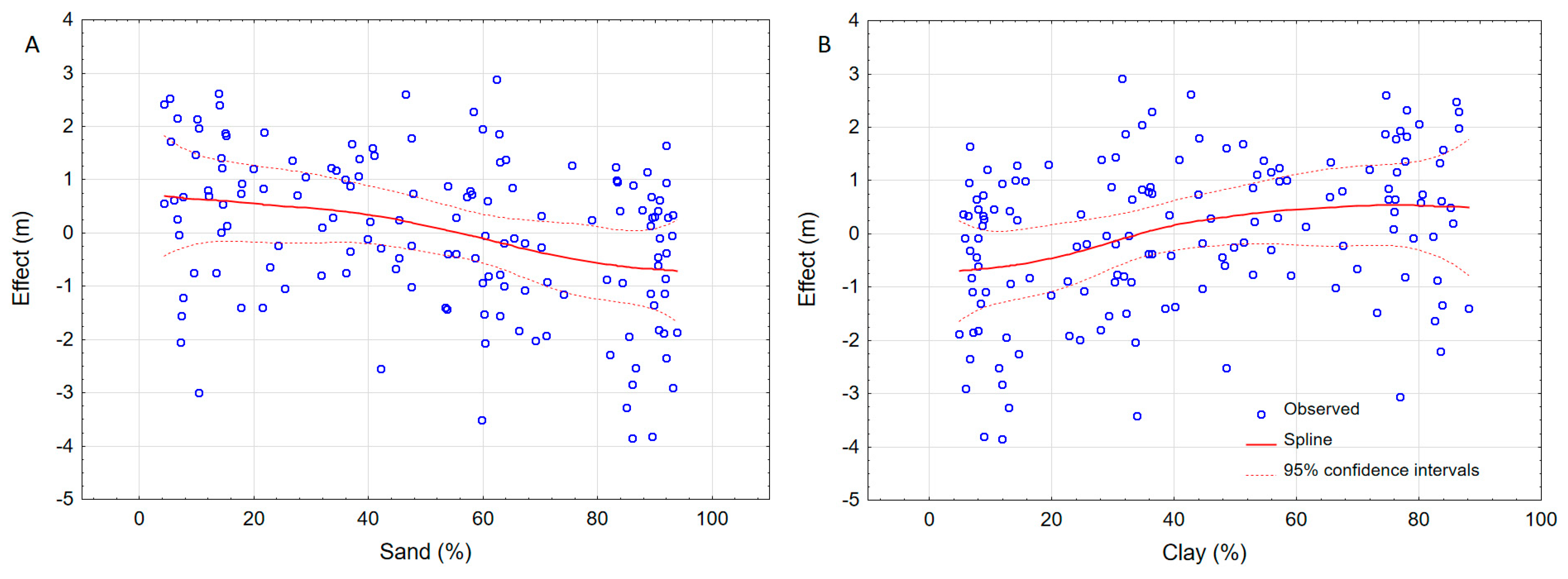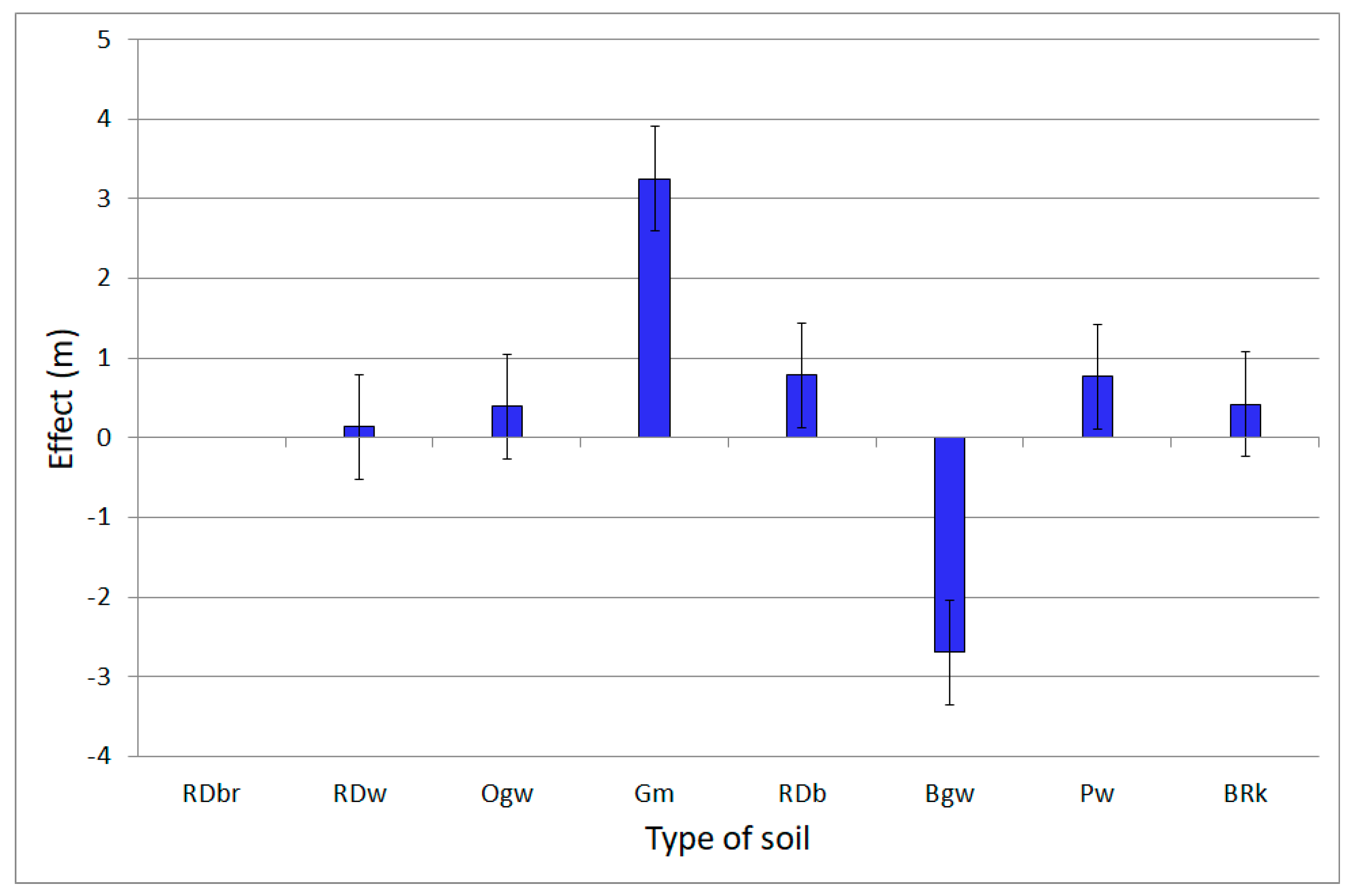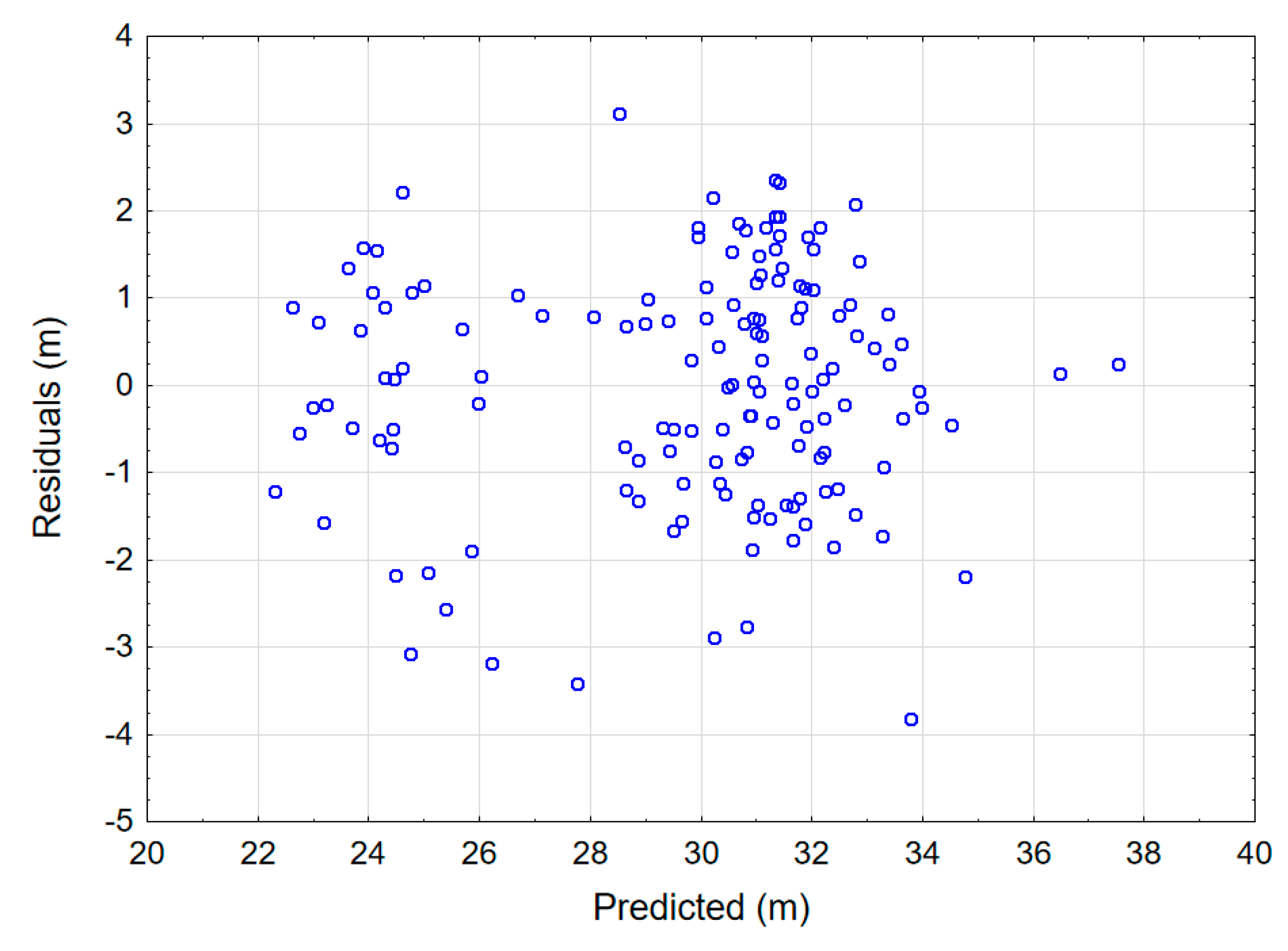Environmental Drivers and Age Trends in Site Productivity for Oak in Southern Poland
Abstract
1. Introduction
2. Methods
2.1. Study Area
2.2. Data
2.2.1. Sample Plot Data
2.2.2. Soil Data and Physiography
2.3. Model Development
- mean absolute error: MAE ;
- root mean squared error: ;
- where is the observed value and is the predicted value.
- adjusted coefficient of determination: ;
3. Results
4. Discussion
5. Conclusions
Author Contributions
Funding
Data Availability Statement
Conflicts of Interest
References
- Skovsgaard, J.P.; Vanclay, J.K. Forest site productivity: A review of the evolution of dendrometric concepts for even-aged stands. Forestry 2008, 81, 13–31. [Google Scholar] [CrossRef]
- Pretzsch, H.; Grote, R.; Reineking, B.; Rötzer, T.; Seifert, S. Models for forest ecosystem management: A European perspective. Ann. Bot. 2008, 101, 1065–1087. [Google Scholar] [CrossRef]
- Splechtna, B.E. Height growth and site index models for Pacific silver fir in southwestern British Columbia. J. Ecosyst. Manag. 2001, 1, 1–14. [Google Scholar]
- Brandl, S.; Falk, W.; Klemmt, H.-J.; Stricker, G.; Bender, A.; Rötzer, T.; Pretzsch, H. Possibilities and Limitations of Spatially Explicit Site Index Modelling for Spruce Based on National Forest Inventory Data and Digital Maps of Soil and Climate in Bavaria (SE Germany). Forests 2014, 5, 2626–2646. [Google Scholar] [CrossRef]
- Bontemps, J.-D.; Bouriaud, O. Predictive approaches to forest site productivity: Recent trends, challenges and future perspectives. Forestry 2013, 87, 109–128. [Google Scholar] [CrossRef]
- Hägglund, B.; Lundmark, J.E. Site index estimation by means of site properties of Scots pine and Norway spruce in Sweden. Stud. Suec. 1977, 138, 5–38. [Google Scholar]
- Raulier, F.; Lambert, M.-C.; Pothier, D.; Ung, C.-H. Impact of dominant tree dynamics on site index curves. Ecol. Manag. 2003, 184, 65–78. [Google Scholar] [CrossRef]
- Tewari, V.P.; Rivas, J.J.C.; VilČko, F.; Gadow, K. Von Height-Growth and site index equations for social forestry plantations of acacia nilotica and eucalyptus hybrid in gujarat state of India. Trees Livelihoods 2007, 17, 125–140. [Google Scholar] [CrossRef]
- Weiskittel, A.R.; Hann, D.W.; Kershaw, J.A., Jr.; Vanclay, J.K. Forest Growth and Yield Modeling; John Wiley & Sons: Hoboken, NJ, USA, 2011. [Google Scholar]
- Dănescu, A.; Albrecht, A.T.; Bauhus, J.; Kohnle, U. Geocentric alternatives to site index for modeling tree increment in uneven-aged mixed stands. Ecol. Manag. 2017, 392, 1–12. [Google Scholar] [CrossRef]
- Chen, H.Y.H.; Krestov, P.V.; Klinka, K. Trembling aspen site index in relation to environmental measures of site quality at two spatial scales. Can. J. Res. 2002, 32, 112–119. [Google Scholar] [CrossRef]
- Wang, G.G.; Klinka, K. Use of synoptic variables in predicting white spruce site index. Ecol. Manag. 1996, 80, 95–105. [Google Scholar] [CrossRef]
- Socha, J. Effect of topography and geology on the site index of Picea abies in the West Carpathian, Poland. Scand. J. Res. 2008, 23, 203–213. [Google Scholar] [CrossRef]
- Gholz, H.L.; Ewel, K.C.; Teskey, R.O. Water and forest productivity. Ecol. Manag. 1990, 30, 1–18. [Google Scholar] [CrossRef]
- Raison, R.J.; Khanna, P.K.; Connell, M.J.; Falkiner, R.A. Effects of water availability and fertilization on nitrogen cycling in a stand of Pinus radiata. Ecol. Manag. 1990, 30, 31–43. [Google Scholar] [CrossRef]
- Vacchiano, G.; Magnani, F.; Collalti, A. Modeling Italian forests: State of the art and future challenges. Iforest Biogeosci. 2012, 5, 113–120. [Google Scholar] [CrossRef]
- Kahle, H.P.; Karjalainen, T.; Schuck, A.; Ågren, G.I.; Kellomäki, S.; Mellert, K.H.; Prietzel, J.; Rehfuess, K.E.; Spiecker, H. Causes and Consequences of Forest Growth Trends in Europe-Results of the RECOGNITION Project; EFI Research Report 21; Brill Leiden: Boston, MA, USA, 2008; pp. 68–85. [Google Scholar]
- Claessens, H.P.D.T.A.; Rondeu. J. Site index curves and autecology of ash, sycamore and cherry in Wallonia (Southern Belgium). Forestry 1999, 72, 171–182. [Google Scholar] [CrossRef]
- Galloway, J.N.; Townsend, A.R.; Erisman, J.W.; Bekunda, M.; Cai, Z.; Freney, J.R.; Martinelli, L.A.; Seitzinger, S.P.; Sutton, M.A. Transformation of the Nitrogen Cycle: Recent Trends, Questions, and Potential Solutions. Science 2008, 320, 889–892. [Google Scholar] [CrossRef]
- Reay, D.S.; Dentener, F.; Smith, P.; Grace, J.; Feely, R.A. Global nitrogen deposition and carbon sinks. Nat. Geosci. 2008, 1, 430–437. [Google Scholar] [CrossRef]
- Etzold, S.; Ferretti, M.; Reinds, G.J.; Solberg, S.; Gessler, A.; Waldner, P.; Schaub, M.; Simpson, D.; Benham, S.; Hansen, K.; et al. Nitrogen deposition is the most important environmental driver of growth of pure, even-aged and managed European forests. Ecol. Manag. 2020, 458, 117762. [Google Scholar] [CrossRef]
- Pretzsch, H.; Biber, P.; Schütze, G.; Uhl, E.; Rötzer, T. Forest stand growth dynamics in Central Europe have accelerated since 1870. Nat. Commun. 2014, 5, 4967. [Google Scholar] [CrossRef]
- Albert, M.; Schmidt, M. Climate-sensitive modelling of site-productivity relationships for Norway spruce (Picea abies (L.) Karst.) and common beech (Fagus sylvatica L.). Ecol. Manag. 2010, 259, 739–749. [Google Scholar] [CrossRef]
- Bravo-Oviedo, A.; Gallardo-Andrés, C.; del Río, M.; Montero, G. Regional changes of Pinus pinaster site index in Spain using a climate-based dominant height model. Can. J. Res. 2010, 40, 2036–2048. [Google Scholar] [CrossRef]
- Socha, J.; Coops, N.C.; Ochal, W. Assessment of age bias in site index equations. IForest 2016, 9, 402–408. [Google Scholar] [CrossRef]
- Sharma, R.P.; Brunner, A.; Eid, T. Site index prediction from site and climate variables for Norway spruce and Scots pine in Norway. Scand. J. Res. 2012, 27, 619–636. [Google Scholar] [CrossRef]
- Elfving, B.; Tegnhammar, L. Trends of tree growth in Swedish forests 1953−1992: An analysis based on sample trees from the national forest inventory. Scand. J. Res. 1996, 11, 26–37. [Google Scholar] [CrossRef]
- Kiviste, A. Site Index Change in the 1950s-1990s according to Estonian Forest Inventory Data. In Proceedings of the International Seminar Held, Nancy, France, 14–16 May 1998; pp. 87–100. [Google Scholar]
- Solberg, S.; Dobbertin, M.; Reinds, G.J.; Lange, H.; Andreassen, K.; Fernandez, P.G.; Hildingsson, A.; de Vries, W. Analyses of the impact of changes in atmospheric deposition and climate on forest growth in European monitoring plots: A stand growth approach. Ecol. Manag. 2009, 258, 1735–1750. [Google Scholar] [CrossRef]
- Yue, C.; Mäkinen, H.; Klädtke, J.; Kohnle, U. An approach to assessing site index changes of Norway spruce based on spatially and temporally disjunct measurement series. Ecol. Manag. 2014, 323, 10–19. [Google Scholar] [CrossRef]
- Metslaid, S.; Sims, A.; Kangur, A.; Hordo, M.; Jõgiste, K.; Kiviste, A.; Hari, P. Growth patterns from different forest generations of Scots pine in Estonia. J. Res. 2011, 16, 237–243. [Google Scholar] [CrossRef]
- Bontemps, J.-D.; Hervé, J.-C.; Dhôte, J.-F. Long-Term Changes in Forest Productivity: A Consistent Assessment in Even-Aged Stands. For. Sci. 2009, 55, 549–564. [Google Scholar]
- del Barrio, G.; Harrison, P.A.; Berry, P.M.; Butt, N.; Sanjuan, M.E.; Pearson, R.G.; Dawson, T. Integrating multiple modelling approaches to predict the potential impacts of climate change on species’ distributions in contrasting regions: Comparison and implications for policy. Environ. Sci. Policy 2006, 9, 129–147. [Google Scholar] [CrossRef]
- Nabuurs, G.J.; Pussinen, A.; Karjalainen, T.; Erhard, M.; Kramer, K. Stemwood volume increment changes in European forests due to climate change-A simulation study with the EFISCEN model. Glob. Chang. Biol. 2002, 8, 304–316. [Google Scholar] [CrossRef]
- Dyderski, M.K.; Paź, S.; Frelich, L.E.; Jagodziński, A.M. How much does climate change threaten European forest tree species distributions? Glob. Chang. Biol. 2018, 24, 1150–1163. [Google Scholar] [CrossRef]
- Hanewinkel, M.; Cullmann, D.A.; Schelhaas, M.-J.; Nabuurs, G.-J.; Zimmermann, N.E. Climate change may cause severe loss in the economic value of European forest land. Nat. Clim. Chang. 2012, 3, 203–207. [Google Scholar] [CrossRef]
- Aertsen, W.; Kint, V.; de Vos, B.; Deckers, J.; van Orshoven, J.; Muys, B. Predicting forest site productivity in temperate lowland from forest floor, soil and litterfall characteristics using boosted regression trees. Plant. Soil 2012, 354, 157–172. [Google Scholar] [CrossRef]
- Starkel, L.; Baugart- Kotarba, M.; Michna, E.; Gil, E.; Pohl, J.; Słupik, J.; Zawora, T. Studia Nad Typologią I Oceną Środowiska Geograficznego Karpat I Kotliny Sandomierskiej. Pract. Geogr. 1978, 125. [Google Scholar]
- Garcia, O.; Batho, A. Top Height Estimation in Lodgepole Pine. West. J. Appl. 2005, 20, 64–68. [Google Scholar]
- Socha, J.; Tymińska-Czabańska, L.; Grabska, E.; Orzeł, S. Site Index Models for Main Forest-Forming Tree Species in Poland. Forests 2020, 11, 301. [Google Scholar] [CrossRef]
- Anta, M.B.; Dorado, F.C.; Diéguez-Aranda, U.; Álvarez González, J.G.; Parresol, B.R.; Soalleiro, R.R. Development of a basal area growth system for maritime pine in northwestern Spain using the generalized algebraic difference approach. Can. J. Res. 2006, 36, 1461–1474. [Google Scholar] [CrossRef]
- Mapa Gleb Polski 1:500 000 [Detailed Soil Map of Poland 1:500 000]; Instytut Uprawy Nawożenia i Gleboznawstwa Państwowy Instytut Badawczy: Warszawa, Poland, 2014. (In Polish)
- EU-DEM v1.1. Available online: https://land.copernicus.eu/imagery-in-situ/eu-dem/eu-dem-v1.1?tab=metadata (accessed on 30 November 2019).
- Siwek, J.; Wacławik, W. Can analytical shading be art? Pol. Cart. Rev. 2016, 47, 121–135. [Google Scholar] [CrossRef]
- Weiss, A. Topographic Position and Landforms Analysis. In Proceedings of the ESRI User Conference, San Diego, CA, USA, 8–12 July 2001. [Google Scholar]
- Szczegółowa Mapa Geologiczna Polski 1:500 000 [Detailed Geological Map of Poland 1:500 000]; Państwowy Instytut Geologiczny: Warszawa, Poland, 2006. (In Polish)
- Aertsen, W.; Kint, V.; van Orshoven, J.; Özkan, K.; Muys, B. Comparison and ranking of different modelling techniques for prediction of site index in Mediterranean mountain forests. Ecol. Model. 2010, 221, 1119–1130. [Google Scholar] [CrossRef]
- Hastie, T.J.; Tibshirani, R.J. Generalized Additive Models; CRC Press: Boca Raton, FL, USA, 1990. [Google Scholar]
- Larsen, K. GAM: The Predictive Modeling Silver Bullet. Stitch Fix 2015, 30, 196–223. [Google Scholar]
- R Core Team. R: A Language and Environment for Statistical Computing; R Foundation for Statistical Computing: Vienna, Austria, 2020; Available online: http://www.R-project.org/ (accessed on 21 December 2020).
- Tegnhammar, L. On the Estimation of Site Index for Norway Spruce; Department of Forest Survey Report 53; Swedish University of Agricultural Sciences: Uppsala, Sweden, 1992; p. 259. ISSN 0348-0496. (In Swedish with English Summary). [Google Scholar]
- Nothdurft, A.; Wolf, T.; Ringeler, A.; Böhner, J.; Saborowski, J. Spatio-temporal prediction of site index based on forest inventories and climate change scenarios. Ecol. Manag. 2012, 279, 97–111. [Google Scholar] [CrossRef]
- Pietrzykowski, M.; Socha, J.; van Doorn, N.S. Scots pine (Pinus sylvestris L.) site index in relation to physico-chemical and biological properties in reclaimed mine soils. New For. 2015, 46, 247–266. [Google Scholar] [CrossRef]
- Gradziński, R.; Kostecka, A.; Radomski, A.; Unrug, R. Sedymentologia. Wydaw. Geol. 1976, 628. [Google Scholar]
- Köstler, J.N.; Brückner, E.; Bibelriether, H. Die Wurzeln der Waldbäume: Untersuchungen zur Morphologie der Waldbäume in Mitteleuropa; Verlag, P., Ed.; Parey: Hamburg, Germany, 1968. [Google Scholar]
- Monserud, R.A.; Rehfeldt, G.E. Genetic and Environmental Components of Variation of Site Index in Inland Douglas-Fir. Science 1990, 36, 1–9. [Google Scholar]
- Lyr, H. Effect of the root temperature on growth parameters of H Lyr to cite this version: HAL Id: Hal-00883054 Effect of the root temperature on growth parameters. Ann. For. Sci. 1996, 53, 317–323. [Google Scholar] [CrossRef]
- Bettinger, P. Forest management in a climate change era: Options for planning Forest Management Climate Change Era: Options for Planning. J. Plan. 2011, 16, 57–66. [Google Scholar]
- Yue, C.; Kahle, H.-P.; von Wilpert, K.; Kohnle, U. A dynamic environment-sensitive site index model for the prediction of site productivity potential under climate change. Ecol. Model. 2016, 337, 48–62. [Google Scholar] [CrossRef]
- Fontes, L.; Bontemps, J.-D.; Bugmann, H.; Van Oijen, M.; Gracia, C.; Kramer, K.; Lindner, M.; Rötzer, T.; Skovsgaard, J.P. Models for supporting forest management in a changing environment. For. Syst. 2010, 19, 8–29. [Google Scholar] [CrossRef]
- Lo, Y.-H.; Hamish, J.P.; Seely, B.; Welham, C. Linking Climate Change and Forest Ecophysiology to Project Future Trends in Tree Growth: A Review of Forest Models. In Climate Change-Research Technology Adaptation Mitigation; Janeza Trdine: Rijeka, Croatia, 2011. [Google Scholar]








| Biometric Parameters | Statistics | |||
|---|---|---|---|---|
| Mean | Minimum | Maximum | Standard Deviation | |
| Age (years) | 84 | 21 | 139 | 27.6 |
| Plot area (ha) | 0.07 | 0.02 | 0.12 | 0.03 |
| Number of trees per ha | 371 | 75 | 2350 | 241.2 |
| Mean diameter (cm) | 33.2 | 9.4 | 50.6 | 7.78 |
| Mean height (m) | 25.2 | 9.1 | 31.3 | 3.31 |
| Volume (m2/ha) | 368.01 | 30.03 | 742 | 144.4 |
| Variable/Unit | Mean | SD | Min | Max |
|---|---|---|---|---|
| Hillshadep (unitless) | 178.66 | 6.4 | 158 | 195 |
| Landform (unitless) | 6.21 | 2.14 | 1 | 10 |
| Slope (unitless) | 4.13 | 1.45 | 1 | 6 |
| TPI1500 (unitless) | 6.07 | 7.94 | −21.50 | 36.53 |
| TPI900 (unitless) | 3.65 | 6.16 | −17.34 | 24.86 |
| Altitude (m) | 221.36 | 37.31 | 169 | 324 |
| pH H2O (unitless) | 4.56 | 0.37 | 3.96 | 6.71 |
| pH KCl (unitless) | 3.86 | 0.35 | 3.16 | 6.01 |
| Sand (%) | 52.72 | 32.8 | 4.25 | 230.3 |
| Clay (%) | 41.93 | 27.03 | 4.9 | 88.15 |
| Silt (%) | 6.5 | 3.98 | 0.7 | 35 |
| N (% of dry mass) | 0.03 | 0.032 | 0.003 | 0.19 |
| C (% of dry mass) | 0.72 | 0.374 | 0.217 | 2.25 |
| C/N (unitless) | 26.39 | 14.4 | 11.52 | 88.5 |
| SI (m) | 29.78 | 3.56 | 21.09 | 37.77 |
| Type of geology substrate | 1—Quaternary aeolian sand; 2—Quaternary sand and residual gravel with boulders; 3—Tertiary Neogene Krakowieckie clay; 4—Quaternary South Polish Pleistocene sand, silt, and gravel; 5—Quaternary Pleistocene glacial till; 6—Quaternary Holocene fluvial deposits; 7—Quaternary dune aeolian sand; 8—Quaternary Pleistocene sand and gravel with boulders; 9—Quaternary Holocene preglacial sand and gravel; 10—Quaternary Pleistocene glacial till residuum; 11—Quaternary South Poland Pleistocene glacial till and its residuum; 12—Quaternary Pleistocene loess; 13—Cambrian mudstone, claystone, and sandstone; 14—Devonian limestone; 15—Quaternary Pleistocene sand, glaciofluvial, and fluvial gravel; 16—Quaternary Pleistocene loess with fossil soil and Baltic glaciation; 17—Cambrian claystone, clay-slate, mudstone, sandstone, and quartzitic sandstone; 18—Quaternary Pleistocene periglacial deposits; 19—Quaternary Holocene fluvial deposits in general. | |||
| Type of soil | 1—rusty brown soils; 2—proper rusty soils; 3—gleysols; 4—gley-podzol mucky soils; 5—podzolised rusty soils; 6—gley-podzol soils; 7—clay-illuvial soils; 8—acid brown soils. | |||
Publisher’s Note: MDPI stays neutral with regard to jurisdictional claims in published maps and institutional affiliations. |
© 2021 by the authors. Licensee MDPI, Basel, Switzerland. This article is an open access article distributed under the terms and conditions of the Creative Commons Attribution (CC BY) license (http://creativecommons.org/licenses/by/4.0/).
Share and Cite
Tymińska-Czabańska, L.; Socha, J.; Maj, M.; Cywicka, D.; Hoang Duong, X.V. Environmental Drivers and Age Trends in Site Productivity for Oak in Southern Poland. Forests 2021, 12, 209. https://doi.org/10.3390/f12020209
Tymińska-Czabańska L, Socha J, Maj M, Cywicka D, Hoang Duong XV. Environmental Drivers and Age Trends in Site Productivity for Oak in Southern Poland. Forests. 2021; 12(2):209. https://doi.org/10.3390/f12020209
Chicago/Turabian StyleTymińska-Czabańska, Luiza, Jarosław Socha, Marek Maj, Dominika Cywicka, and Xo Viet Hoang Duong. 2021. "Environmental Drivers and Age Trends in Site Productivity for Oak in Southern Poland" Forests 12, no. 2: 209. https://doi.org/10.3390/f12020209
APA StyleTymińska-Czabańska, L., Socha, J., Maj, M., Cywicka, D., & Hoang Duong, X. V. (2021). Environmental Drivers and Age Trends in Site Productivity for Oak in Southern Poland. Forests, 12(2), 209. https://doi.org/10.3390/f12020209








